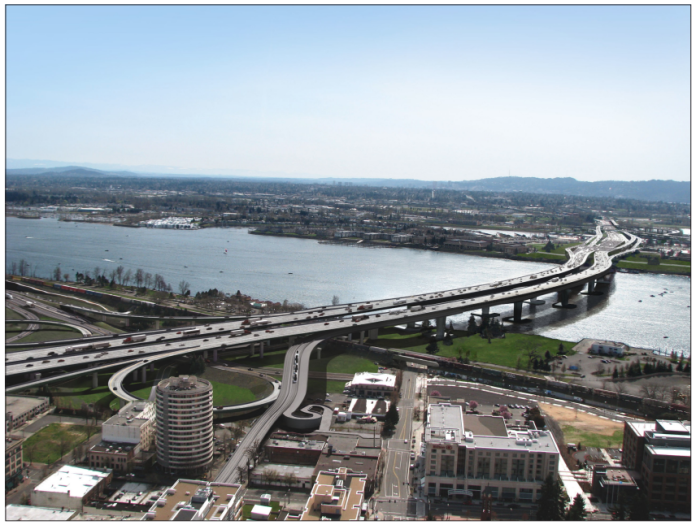
State Democrats propose diverting $2 billion from the general fund to fund their highway package, but this money would be better spent on affordable housing.
Move Ahead Washington is a big improvement over past state transportation packages but it still doesn’t do enough when it comes to addressing the state’s climate, racial equity, and mobility justice goals. Spending $4 billion on highway widening in the 2020s — as our state desperately tries to meet its climate goals and avert environmental catastrophe — is folly. Even worse is that $2 billion of these dollars would be diverted from the general fund, robbing the state of capacity to invest in more pressing needs.
The Washington State Legislature should cut $2 billion in highway widening out of Move Ahead Washington and dedicate that money to affordable housing investments instead, which a recent poll showed was voters’ top concern in the state. Expanded highways actively do harm, adding climate emissions and pollution that fall hardest on low-income communities of color across the state, as the Front and Centered Coalition has argued, pointing to State health disparities maps starkly illustrating their point. Affordable housing actively does good by lessening displacement, alleviating homelessness, and improving outcomes for everyone.
“We need to stop asking BIPOC (Black, Indigenous, People of Color) communities to bear the cost of our addiction to oil and autos,” said Paolo Nunes-Ueno of Front and Centered in a statement. “If we keep going this way, widening highways and roads while neglecting transit and sidewalks, we will lock in emissions for decades to come and lock many people out of opportunities to thrive.”
Cutting $2 billion from the state transportation package won’t be all that hard considering all the highway projects of dubious value in the package. Here’s just five of the biggest clunkers:
- SR-18 – $640 million
- US-2 trestle – $210 million
- Halve the Interstate Bridge Replacement (IBR) to strip widening elements – $500 million
- Puget Sound Gateway – $434 million
- I-405/SR-167 corridor improvements – $380 million
While SR-18 splits Tiger Mountain State Forest from other state forest land, the other four projects would significantly impact population centers, many of them low-income communities of color, and burden them with pollution. Plus, having a noisy widened highway next to a major park and popular trailheads is not anyone’s idea of improving the recreational experience either.
Perhaps, the big highway widening investments are not something of which Democrats are terribly proud. Their recent communications have celebrated the other aspects of their package and ignored $4 billion in highway widening, as shown below.
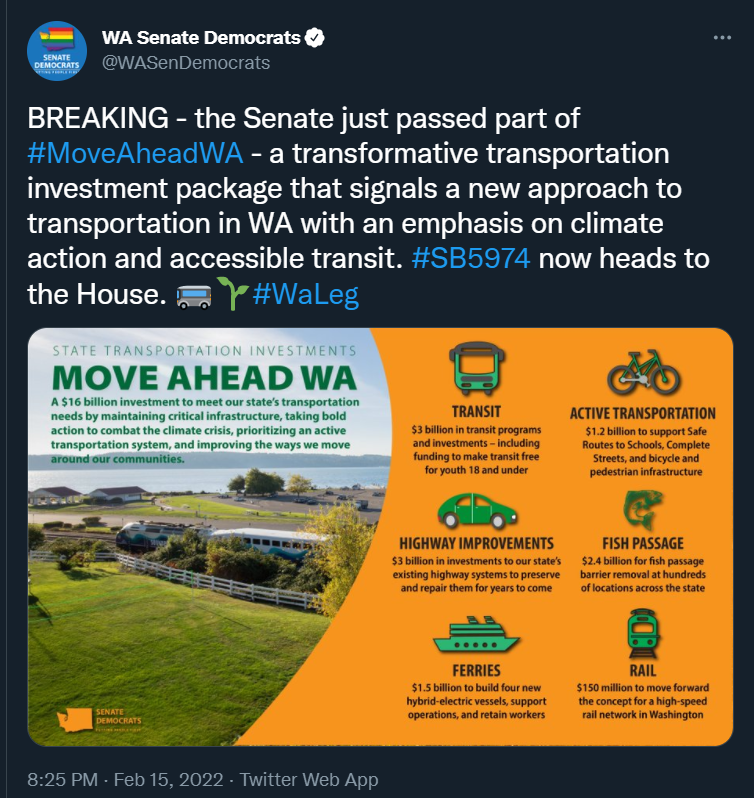
What are our priorities?
Cutting the four projects mentioned above and halving the IBR would result in $2.16 billion in savings from the most egregious highway expansion programs in Move Ahead Washington. It would also alleviate the need to transfer $2 billion from the general fund. This money would be better spent on affordable housing and homelessness services, or a number of other higher priorities like education. Instead of widening these five highways, imagine Washington State building 10,000 permanently affordable homes and 10,000 emergency shelter spaces. It could make a real dent in the homelessness crisis.
Widened highways have an incredibly persistent tendency to become just as full of cars and congested as they were before because motorists make more trips and developers build more sprawl following highway expansion, particularly when transit continues to be an afterthought. Planners and engineers call this phenomenon the law of induced demand, which makes highway widening an unwise long-term investment before even factoring in the climate emissions these widened facilities would lock in. In contrast, 10,000 deeply affordable homes would continue reaping benefits for generations and help alleviate our current housing affordability crisis, as well as the next one looming down the line.
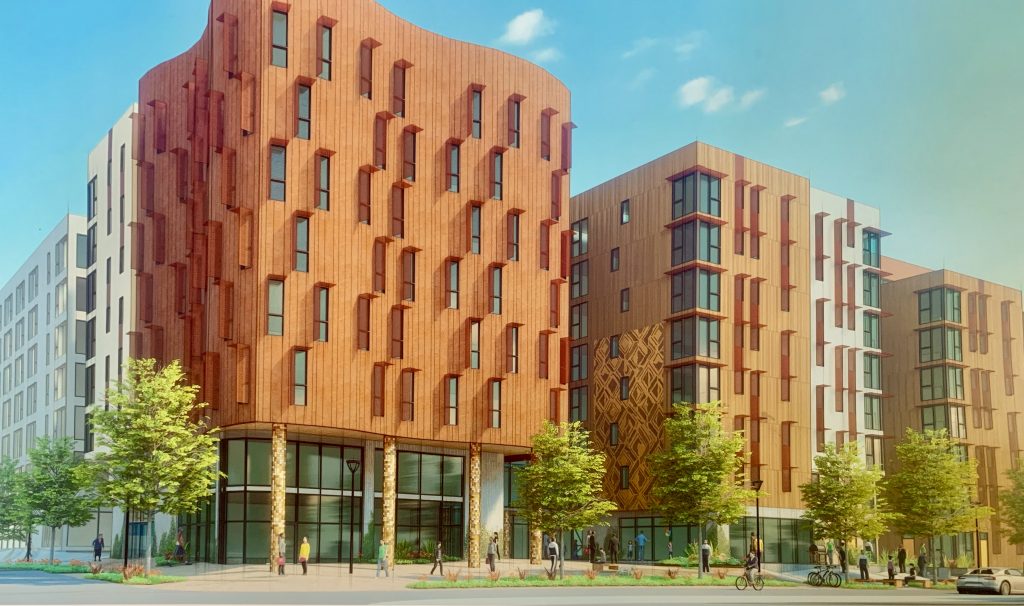
Governor Jay Inslee has proposed an $815 million homelessness plan in his supplemental budget — less than half of the $2 billion infusion of general fund dollars for highway expansion and not enough to make a major dent in the problem. Using general fund dollars on highway expansion had been taboo in previous sessions and it’s a bad precedent to set. The state must grapple with how to replace the gas tax to fund roads as more of the vehicle fleet electrifies. Simply hollowing out the general fund is a bad answer to that question, and it’s also a poor prioritization of funds over the next decade. Why not invest in housing and homelessness services instead of highway pork barrel spending that won’t even solve the problem it claims to solve?
When it comes to a long-term vision for mobility, the Washington State Department of Transportation (WSDOT) has started singing a different tune and increasing stressed transit, walkability, and safety. When WSDOT secretary Roger Millar talks (we hosted him at a meetup last March), he sounds like an urbanist and safe streets advocate. However, when it comes to near-term priorities, WSDOT is still investing like it’s the 1990s, when its current plans were hatched, and the agency continues spinning narratives to support their highway widening schemes — long-term vision be damned.
Columbia River Crossing: A zombie project back from the dead
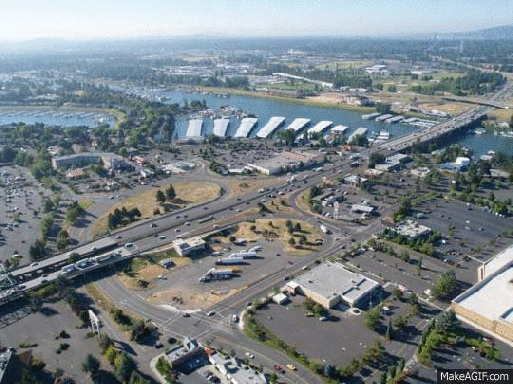
The Interstate Bridge Replacement program formerly known as the Columbia River Crossing is a great example of this. At $1 billion, it’s the single largest project in the package — and the total project cost is more like $5 billion. Boosters swear the project is all about earthquake-proofing the bridge and stress a multi-use trail that would be added. President Joe Biden added it to a list of “economically significant bridges” as the primary artery between Western Washington and Western Oregon. However, drilling down into project elements, it’s clear a huge part of the project is widening a five-mile segment of the freeway through Vancouver and supercharging interchanges. Renderings from the failed early push to do the project in 2007 showed the widened freeway’s massive footprint.
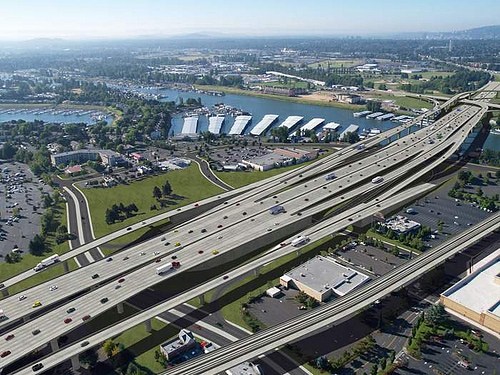
Now in the reboot of the project, officials are being cagey and evasive about even producing visualizations or defining what the project is as they ask for a $1 billion commitment from the state of Washington. Why make such a large commitment without even getting to see what we’re paying for? Having an earthquake-resilient bridge between Vancouver and Portland that supports light rail and perhaps even high-speed rail is a worthy goal. Stripping the project down to that element could save billions and get a better outcome.
At the very least, officials should make it clear what they’re funding. The images shared above are from the earlier Columbia River Crossing iteration of the project, which failed to win approval and led to today’s “Interstate Bridge Replacement” rebrand. The rebranded project promises everything to everybody, but the highway widening seems most assured. Technically, officials only promise a “light rail-ready” bridge rather than assuring Vancouverites that funding this project would actually lead to a light rail connection to Portland. And when high speed rail finally connects the corridor, they may end up needing to build another multi-billion-dollar bridge.
Bridge proviso demanding climate accounting
Working with the Move All Seattle Sustainably (MASS) Coalition, The Urbanist proposed a bridge proviso for the state transportation package and shared it with lawmakers that would offer some guardrails on investments, ensuring they further transit and climate goals and grapple with the law of induced demand.
Bridge planning and construction work, defined as designs, studies, or engineering related to the planning or construction of bridges funded by this bill, must address how the project will:
- Further Washington State’s climate action plan and comply with targeted carbon emissions limits laid out in RCW 70.235.020.
- Account for and mitigate induced demand for automobile trips the project would cause.
- Address and further transit plans in the same corridor and all associated transit-oriented development plans.
- State the impacts of the project on Vehicle Miles Traveled (VMT) targets as developed by the Washington State Department of Transportation and explain any discrepancy between the project’s VMT projections and WSDOT’s targets.
Maintaining our bridges and roads is important. But, as this editorial board has argued previously, we must also ensure our state is meeting its climate, equity, and livability goals. The bridges we’re building have to work for future generations and carry us into the next century. We keep building highways like there’s no tomorrow, and that has to stop.
The Urbanist’s editorial board consists of Natalie Bicknell Argerious, Stephen Fesler, Shaun Kuo, Ryan Packer, and Doug Trumm.
The Urbanist was founded in 2014 to examine and influence urban policies. We believe cities provide unique opportunities for addressing many of the most challenging social, environmental, and economic problems. We serve as a resource for promoting and disseminating ideas, creating community, increasing political participation, and improving the places we live.

